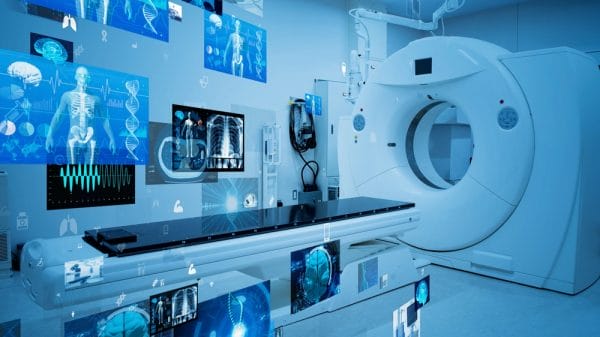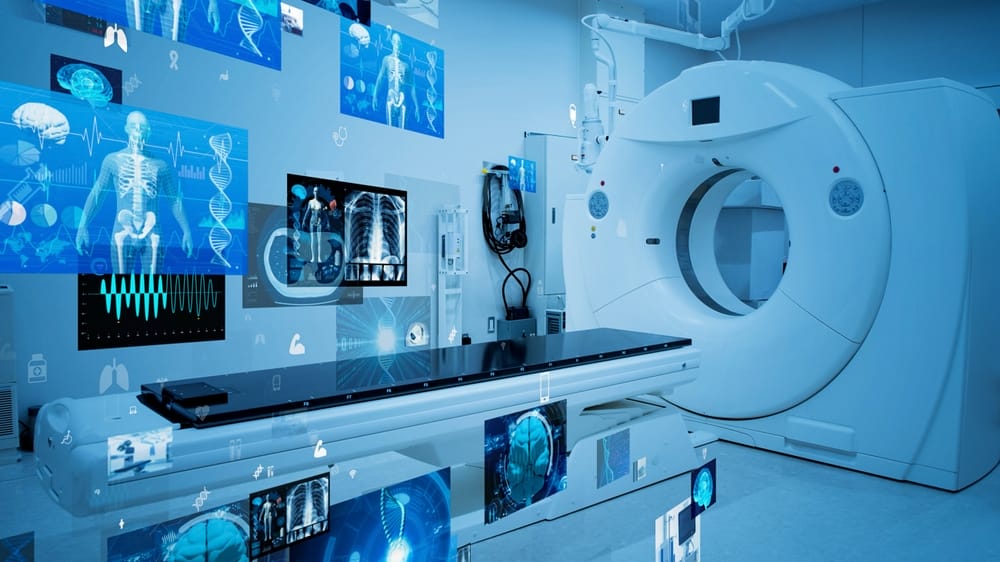
AI in medical imaging addresses diagnostic backlogs by automating tasks like image segmentation and generating reports. It also integrates imaging results with a patient’s electronic health record.
Platinum Mobile Imaging’s AI medical imaging workflow is transforming the field of diagnostic medicine. Whether it is detecting subtle fractures or identifying early-stage tumors, AI can improve clinician workflows and help them deliver fast, more accurate results.
Benefits of AI Medical Imaging
Healthcare professionals can now diagnose and treat patients based on data found using AI medical imaging. There are additional benefits as well:
- Detecting Problems Earlier: AI can identify diseases like cancer earlier by analyzing patient data with exceptional precision. It can detect subtle changes in tissues or irregular tissue growth patterns by using advanced algorithms. This means doctors can begin treating patients at the first sign of illness.
- Tracking Patient Care: AI medical imaging plays a pivotal role in tracking a patient’s progress over time. The AI monitors changes in tumors and other chronic illnesses, which allows providers to create dynamic treatment plans.
- Spotting Unseen Abnormalities: Artificial intelligence in medical imaging detects patterns invisible to traditional methods. This includes microcalcifications in mammograms or subtle brain changes in MRIs, helping to prevent a misdiagnosis and the patient undergoing unneeded treatment.
- Reducing the Workload: Healthcare providers are able to use medical imaging AI to automate their image analysis. Radiologists can process reports faster and more consistently. It also helps clear up backlogs and deliver timely results in high-demand environments.
- Improving Patient Outcomes: Delays in imaging results can cause undue anxiety in patients and their care team. Most diagnostic medicine relies on the outcome of imaging and determines the next steps in treatment. By using AI in medical imaging, patients are informed in an appropriate timeframe, which improves their overall outcome and satisfaction.
Best Use Cases for AI-Powered Medical Imaging
While this technology is still fairly new to the healthcare industry, there has been measurable success in its implementation. AI medical imaging has proven itself to be adaptable across critical departments like diagnostics, but that isn’t the only use case for it.
Cardiovascular Conditions
Medical imaging and AI have the ability to detect abnormalities such as arrhythmias and coronary artery disease. These conditions are often hard to spot and are easily overlooked. AI-powered systems have taken over tasks like aortic valve analysis and have improved the accuracy of echocardiogram readings. Because of this, providers can detect these issues earlier before they become life-threatening. With this AI medical imaging, there has been an improvement in survival rates and long-term cardiac health outcomes.
Cancer Screening
AI tools can analyze the imaging data of a cancer screening and distinguish between malignant and benign growths with high levels of accuracy. This has been especially helpful in more challenging cases in diagnosing breast and prostate cancers. Medical imaging AI also reduces false positives, which can lead to a patient undergoing unnecessary treatment.
Neurological Abnormalities
AI algorithms can analyze CT and MRI results to find micro indicators of Alzheimer’s disease and strokes. This function is especially important in emergency care scenarios, where the time it takes to detect a stroke can mean the difference between full recovery and lasting impairment.
Brain Tumors
Traditional tumor classification can take up to 40 minutes, but advancements in machine learning and MRI imaging have cut this time to just a few minutes. These innovations streamline the process for patients while enhancing accuracy and precision. A recent study showed AI models analyzing MRI scans achieved 98.56% accuracy in brain tumor classification. Similarly, research in the U.K. introduced a non-invasive, AI-driven approach for pediatric tumor classification, marking a significant step forward in pediatric care.
Fractures and Musculoskeletal Injuries
Fractures, particularly hip fractures, are a leading cause of chronic pain and limited mobility in older adults. With advanced diagnostic tools, AI can spot even the smallest fractures and dislocations that traditional imaging might miss. This means faster, more accurate diagnoses and tailored treatment plans. The result is better recovery outcomes and a brighter, more mobile future for those affected by these injuries. AI isn’t just improving healthcare; it’s transforming lives.
Future of Medical Mobile Imaging with AI
Medical imaging AI may be shaping the future of healthcare, but it is not a replacement for the professionals who work in it. AI and providers can work together to improve patient outcomes and provide more accurate care. Healthcare professionals who embrace AI medical imaging will lead the future that leverages their strengths and helps deliver personalized care.
Looking for an innovative medical imaging partner? Platinum Mobile Imaging delivers AI-driven solutions and customer support to enhance healthcare outcomes.


